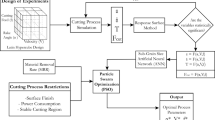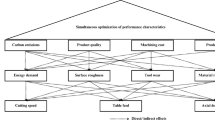Abstract
Nowadays, the miniaturization of many consumer products is extending the use of micro-milling operations with high-quality requirements. However, the impacts of cutting-tool wear on part dimensions, form and surface integrity are not negligible and part quality assurance for a minimum production cost is a challenging task. In fact, industrial practices usually set conservative cutting parameters and early cutting replacement policies in order to minimize the impact of cutting-tool wear on part quality. Although these practices may ensure part integrity, the production cost is far away to be minimized, especially in highly tool-consuming operations like mold and die micro-manufacturing. In this paper, an adaptive control optimization (ACO) system is proposed to estimate cutting-tool wear in terms of part quality and adapt the cutting conditions accordingly in order to minimize the production cost, ensuring quality specifications in hardened steel micro-parts. The ACO system is based on: (1) a monitoring sensor system composed of a dynamometer, (2) an estimation module with Artificial Neural Networks models, (3) an optimization module with evolutionary optimization algorithms, and (4) a CNC interface module. In order to operate in a nearly real-time basis and facilitate the implementation of the ACO system, different evolutionary optimization algorithms are evaluated such as particle swarm optimization (PSO), genetic algorithms (GA), and simulated annealing (SA) in terms of accuracy, precision, and robustness. The results for a given micro-milling operation showed that PSO algorithm performs better than GA and SA algorithms under computing time constraints. Furthermore, the implementation of the final ACO system reported a decrease in the production cost of 12.3 and 29 % in comparison with conservative and high-production strategies, respectively.
Similar content being viewed by others
References
Bissacco G, Hansen HN, Chiffre LD (2005) Micromilling of hardened tool steel for mould making applications. J Mater Process Technol 167:201–207
Vázquez Lepe E, Amaro A, Ciurana QD, Rodríguez González CÁ (2015) Process planning considerations for micromilling of mould cavities used in ultrasonic moulding technology. Precis Eng 39:252–260
Biermann D, Baschin A, Krebs E, Schlenker J (2011) Manufacturing of dies from hardened tool steels by 3-axis micromilling. Prod Eng Res Dev 5:209–217
De Cristofano S, Funaro N, Feriti GC, Rostango M, Comoglio M, Merlo A, Stefanini C, Dario P (2012) High-speed micro-milling: novel coatings for tool wear reduction. Int J Mach Tools Manuf 63:16–20
Aramcharoen A, Mativenga PT, Yang S, Cooke KE, Teer DG (2008) Evaluation and selection of hard coatings for micro milling of hardened tool steel. Int J Mach Tools Manuf 48:1578–1584
Aramcharoen A, Mativenga PT (2008) Size effect and tool geometry in micromilling of tool steel. Precis Eng 33:402–407
Stephenson DA, Agapiou JS (1997) Metal cutting theory and practice. Marcel Dekker, New York
Abellan JV, Romero F, Siller HR, Estruch A, Vila C (2008) Adaptive control optimization of cutting parameters for high quality machining operations based on neural networks and search algorithms, Advances in robotics, automation and control. InTech, Austria, pp 472–491
Koren Y (1989) Adaptive control systems for machining. Manuf Rev 2:6–15
Coker SA, Shin YC (1996) In-process control of surface roughness due to tool wear using a new ultrasonic system. Int J Mach Tools Manuf 36:411–422
Chiang S-T, Liu DI, Lee A-C, Chieng W-H (1995) Adaptive control optimization in end milling using neural networks. Int J Mach Tools Manuf 34:637.660
Malekian M, Park SS, Jun MBG (2009) Tool wear monitoring of micro-milling operations. J Mater Process Technol 209:4903–4914
Tansel I, Trujillo M, Nedouyan A, Velez C, Bao W-Y, Arkan TT, Tansel B (1998) Micro-end-milling—III. Wear estimation and tool breakage detection using acoustic emission signals. Int J Mach Tools Manuf 38:1449–1466
Jemenielniak K, Arrazola PJ (2008) Application of AE and cutting force signals in tool condition monitoring in micro-milling. CIRP J Manuf Sci Technol 1:97–102
Hsieh W-H, Lu M-C, Chiou S-J (2012) Application of backpropagation neural network for spindle vibration-based tool wear monitoring in micro-milling. Int J Adv Manuf Technol 61:53–61
López de Lacalle LN, Lamikiz A, Sánchez JA, Fernández de Bustos I (2006) Recording of real cutting forces along the milling of complex parts. Mechatronics 16:21–32
Huang S, Tan KK, Hong GS, Wong YS (2007) Cutting force control of milling machine. Mechatronics 17:533–541
Kunpeng Z, San WY, Soon HG (2009) Wavelet analysis of sensor signals for tool condition monitoring: a review and some new results. Int J Mach Tools Manuf 49:537–553
Abellán-Nebot JV, Subirón FR (2010) A review of machining monitoring systems based on artificial intelligence process models. Int J Adv Manuf Technol 47:237–257
Elangovan M, Sugumaran V, Ramachandran KI, Ravikumar S (2011) Effect of SVM kernel functions on classification of vibration signals of a single point ``. Expert Syst Appl 38:15202–15207
Dimla DE Sr (2000) Sensor signals for tool-wear monitoring in metal cutting operations—a review of methods. Int J Mach Tools Manuf 40:1073–1098
Saedon JB, Soo SL, Aspinwall DK, Barnacle A, Saad NH (2012) Prediction and optimization of tool life in micromilling AISI D2 (62 HRC) hardened steel. Procedia Eng 41:1674–1683
Silva JA, Abellán-Nebot JV, Siller HR, Guedea-Elizalde F (2012) Adaptive control optimization system for minimizing production cost in hard milling operations. Int J Comput Integr Manuf 27:1–13
Vallejo AJ, Morales-Mendez R (2010) Cost-effective supervisory control system in peripheral milling using HSM. Annu Rev Control 34:155–162
Saikumar S, Shunmugam MS (2011) Development of a feed rate adaption control system for high-speed rough and finish end milling of hardened EN24 steel. Int J Adv Manuf Technol 59:869–884
Zuperl U, Cus F, Reibenschuh M (2011) Neural control strategy of constant cutting force system in end milling. Robot Comput Integr Manuf 27:485–493
Liu Y, Zuo L, Wang C (1999) Intelligent adaptive control in milling processes. Int J Comput Integr Manuf 12:453–460
Dweiri F, Al-Jarrah M, Al-Wedyan H (2003) Fuzzy surface roughness modeling of CNC down milling of alumic-79. J Mater Process Technol 133:266–275
Ho SY, Lee KC, Chen SS, Ho SJ (2002) Accurate modeling and prediction of surface roughness by computer vision operations using an adaptive neuro-fuzzy inference system. Int J Mach Tools Manuf 42:1441–1446
Lou SJ, Chen JC (1999) In-process surface roughness recognition (ISRR) system in end-milling operations. Int J Adv Manuf Technol 15:200–209
Chen JC, Savage M (2001) A fuzzy-net-based multilevel in-process surface roughness recognition system in milling operations. Int J Adv Manuf Technol 17:670–676
Dey S, Stori JA (2005) A Bayesian network approach to root cause diagnosis of process variations. Int J Mach Tools Manuf 45:75–91
Correa M, Bielza C, de Ramirez M, Alique J (2008) A Bayesian network model for surface roughness prediction in the machining process. Int J Syst Sci 39:1181–1192
Salgado DR, Alonso FJ, Cambero I, Marcelo A (2009) In-process surface roughness prediction system using cutting vibrations in turning. Int J Adv Manuf Technol 43(1–2):40–51
Caydas U, Ekici S (2012) Support vector machines models for surface roughness prediction in CNC turning of AISI 304 austenitic stainless steel. J Intell Manuf 23:639–650
Shi D, Gindy NN (2007) Tool wear predictive model based on least squares support vector machines. Mech Syst Signal Process 21:1799–1814
Abellan-Nebot JV (2010) A review of artificial intelligent approaches applied to part accuracy prediction. Int J Mach Mach Mater 1–2:6–37
Dimla DW Jr, Lister PM, Leighton NJ (1997) Neural network solutions to the tool condition monitoring problem in metal cutting—a critical review of methods. Int J Adv Manuf Technol 37:1219–1241
Yusup N, Zain AM, Hashim SZM (2012) Evolutionary techniques in optimizing machining parameters: review and recent applications (2007–2011). Expert Syst Appl 39:9909–9927
Chandrasekaran M, Muralidhar M, Krishna USD (2010) Application of soft computing techniques in machining performance prediction and optimization: a literature review. Int J Adv Manuf Technol 46:445–464
Chen XQ, Li HZ (2009) Development of a tool wear observer model for online tool. Int J Adv Manuf Technol 45:786–800
De Brabanter K, Karsmakers P, Ojeda F, Alzate C, De Brabanter J, Pelckmans K (2011) LS-SVM lab toolbox users guide version 1.8, Leuven, Belgium
Wang ZG, Wong YS, Rahman M (2004) Optimisation of multi-pass milling using genetic algorithm and genetic simulated annealing. Int J Adv Manuf Technol 24:727–732
Aggarwal S, Xirouchakis P (2013) Selecting of optimal cutting conditions for pocket milling using genetic algorithm. Int J Adv Manuf Technol 66:1943–1958
Rai JK, Brand D, Slama M, Xirouchakis P (2011) Optimal selection of cutting parameters in multi-tool milling operations. Int J Prod Res 49:3045–3068
Wibowo A, Ishak Desa M (2012) Kernel based regression and genetic algorithms for estimating cutting conditions. Expert Syst Appl 39:11634–11641
Deepak U (2011) Optimization of milling operation using genetic and PSO algorithm. International Journal of Software Engineering and Soft Computing 1
Lee YZ, Ponnambalam SG (2012) Optimisation of multipass turning operations using PSO and GA-AIS algorithms. Int J Prod Res 50:6499–6518
Lin C-J, Lin P-T (2012) Particle swarm optimization based feedforward controller for a XY PZT positioning stage. Mechatronics 22:614–628
Bharathi Raja S, Baskar N (2010) Optimization techniques for machining operations: a retrospective research based on various mathematical models. Int J Adv Manuf Technol 48:1075–1090
Mohd Zain A, Haron H, Sharif S (2010) Simulated Annealing to estimate the optimal cutting conditions for minimizing surface roughness in end milling Ti–6Al–4V. Mach Sci Technol 14:43–62
Somashekhar KP, Mathew J, Ramachandran N (2012) A feasibility approach by simulated annealing on optimization of micro-wire electric discharge machining parameters. Int J Adv Manuf Technol 61:1209–1213
Olvera D, Elías-Zúñiga A, Martínez-Alfaro H, López de Lacalle LN, Rodríguez CA, Campa FJ (2014) Determination of the stability lobes in milling operations based on homotopy and simulated annealing techniques. Mechatronics 24:177–185
Author information
Authors and Affiliations
Corresponding author
Rights and permissions
About this article
Cite this article
Coppel, R., Abellan-Nebot, J.V., Siller, H.R. et al. Adaptive control optimization in micro-milling of hardened steels—evaluation of optimization approaches. Int J Adv Manuf Technol 84, 2219–2238 (2016). https://doi.org/10.1007/s00170-015-7807-6
Received:
Accepted:
Published:
Issue Date:
DOI: https://doi.org/10.1007/s00170-015-7807-6




